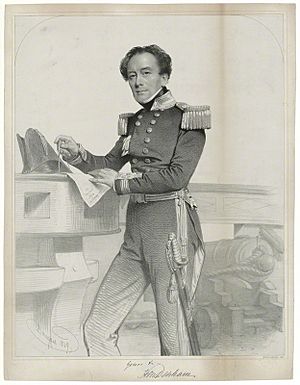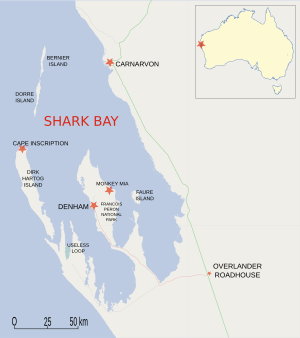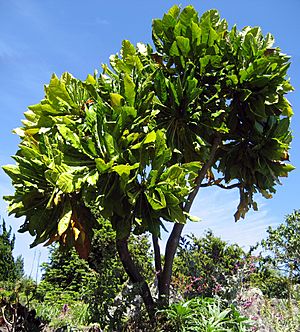Henry Mangles Denham facts for kids
Quick facts for kids
Sir Henry Denham
|
|
|---|---|

Henry Mangles Denham (1849)
by Charles Baugniet |
|
| Born | 28 August 1800 |
| Died | 3 July 1887 (aged 86) |
| Allegiance | |
| Service/ |
|
| Years of service | 1812–1871 |
| Rank | Vice Admiral |
| Commands held | HMS Avon HMS Herald Pacific Station |
| Awards | Companion of the Order of St Michael and St George |

Sir Henry Mangles Denham (born August 28, 1800, died July 3, 1887) was a very important officer in the Royal Navy. He became a Vice Admiral and even led the navy's operations in the Pacific Ocean. He was known for his amazing work in surveying and mapping coastlines and oceans.
Contents
Henry Denham joined the navy in 1809 when he was just nine years old. From 1810 to 1814, he served on HMS Vulture. He helped Captain Martin White survey the Channel Islands. During this time, he became a midshipman.
He continued surveying the Channel Islands until 1817. Then, he worked with Captain White on HMS Shamrock. They surveyed the English Channel and parts of Ireland. In 1822, he was promoted to lieutenant. Later, he surveyed the coast of France and the Bristol Channel.
Solving Shipping Problems in Liverpool
In the early 1830s, the Port of Liverpool was having a big problem. The channels leading to the port were filling up with sand and mud. This made it hard for ships to get in and out. The port asked the Admiralty for help.
In 1833, Denham was sent to survey the area. He did a very detailed study of the Mersey River and its approaches. He figured out how much water flowed and how much sand was moving. He realized that if old channels were blocking, the water must be flowing somewhere else.
Denham found and mapped a brand new channel. He also marked it with buoys to guide ships. This discovery greatly increased the number of ships the port could handle. In 1834, he was honored by the city of Liverpool. He even became the port's Resident Marine Surveyor in 1835.
When the channel started getting shallow again in 1837, Denham came up with a new way to clear it. He used a steamer to pull spiked cables along an oak beam. This method of dredging worked so well that it was used until 1890. His work helped Liverpool become a major port for trade.
Leaving Liverpool
Denham's time in Liverpool ended with some disagreements. He was frustrated because he didn't have enough resources. This became a big problem during a huge storm in 1839. Lightships and buoys were ripped from their anchors. Denham couldn't even hire boats to fix the situation.
Some people also felt he was going beyond his job. He wanted a single group to manage the entire river, not just the port. Because of these issues, his job ended in 1839.
After Liverpool, Denham stayed in northwest England. The Admiralty asked him to survey the coasts of Lancashire and Cumberland. He published his findings in a guide for sailors in 1840.
From 1842, Denham was second-in-command on HMS Lucifer. He helped survey the coast of Ireland. In 1845, he took command of HMS Avon. With this ship, he surveyed the west coast of Africa, including the Niger River mouth. From 1848 to 1851, he investigated accidents at sea.
Exploring the South Pacific (1852-1861)
On February 18, 1852, Denham became captain of HMS Herald. As captain of the Herald, he did huge survey jobs. He mapped areas around Australia, New Caledonia, and other parts of the Southwest Pacific. This work lasted from 1852 to 1861.
His journey on the Herald made him famous in maritime surveying. For ten years, the Herald mapped known lands and dangerous areas in the southwest Pacific. These efforts helped create safe shipping routes. Many of the maps made by the Herald are still used today.
During Denham's voyages, the southwest Pacific was a place for missionaries and traders. Naturalists like William Grant Milne and John MacGillivray joined the expedition. They collected many plant and bird specimens. These collections greatly added to our knowledge of nature.
The voyage started in England on February 21, 1852. The ship arrived in Australia on February 18, 1853. Along the way, they took a deep-sea measurement between Rio de Janeiro and the Cape of Good Hope. It showed a depth of about 14,000 meters (7,706 fathoms)!
The Herald then began its main survey. They visited Lord Howe Island, the Isle of Pines in New Caledonia, and Aneityum in Vanuatu. They also explored New Zealand, Raoul Island, and Fiji.
In June 1855, they visited Norfolk Island. After another visit to Fiji, the Herald helped move the people from Pitcairn Island to Norfolk Island. They then surveyed Port Jackson in New South Wales. They also mapped Bass Strait, King George Sound, and Shark Bay.
The Herald made three visits to the Coral Sea. Finally, the ship began its journey home. It sailed from Sydney to Surabaya and then arrived back in Chatham, England, on June 1, 1861.
Later Life and Honors
From May 1864 to November 1866, Denham was the Commander-in-Chief, Pacific Station. This meant he was in charge of all naval operations in the Pacific. In 1866, he was knighted for his amazing work in mapping the oceans. He retired from the navy in 1871 as a vice admiral.
Many places and things were named after Sir Henry Denham. The town of Denham, Western Australia, is named after him. A tree from New Caledonia, Meryta denhamii, also carries his name. Denham Island in British Columbia was named by another Royal Navy surveyor in his honor.
Family Life
In 1826, Henry Denham married Isabella Cole. Isabella passed away in 1865. Their son, Fleetwood James Denham, served with his father on the Herald. Sadly, Fleetwood died at age 16 in 1854 from a tropical fever. He passed away on Raoul Island, part of New Zealand's Kermadec Islands. He was buried near the beach in Denham Bay, which is also named after him.
See also
- John MacGillivray
- William Grant Milne
- European and American voyages of scientific exploration
Images for kids



